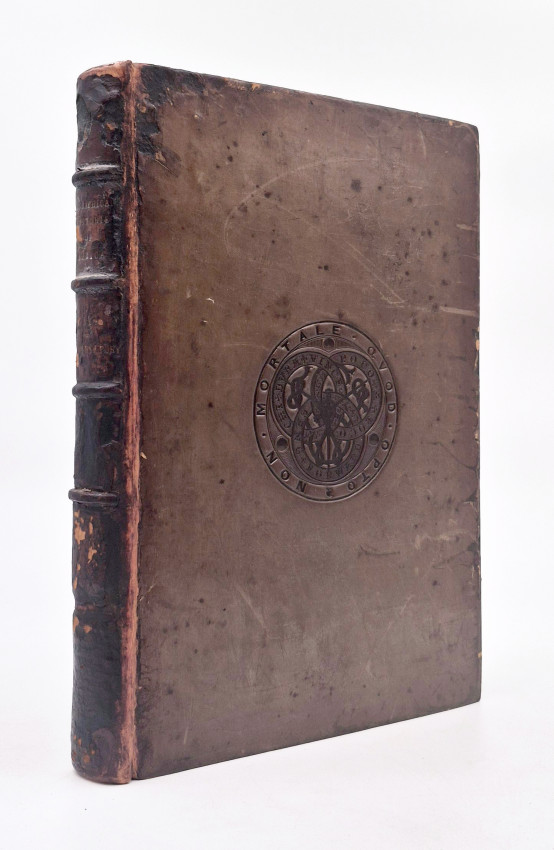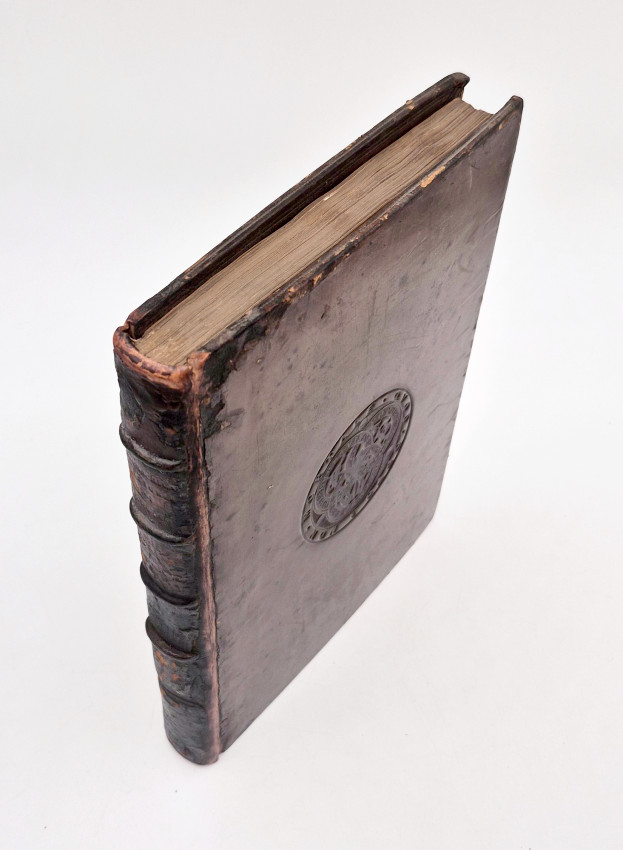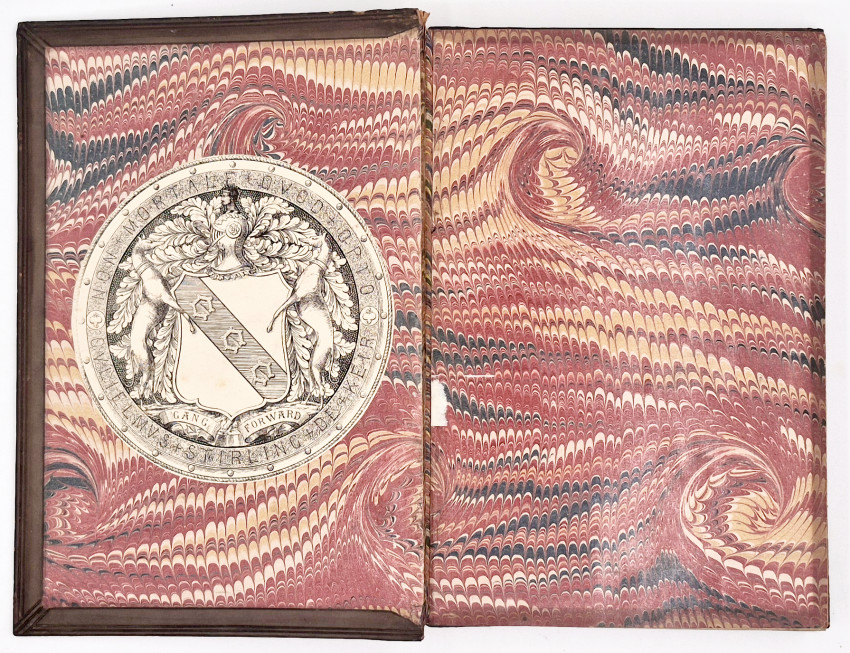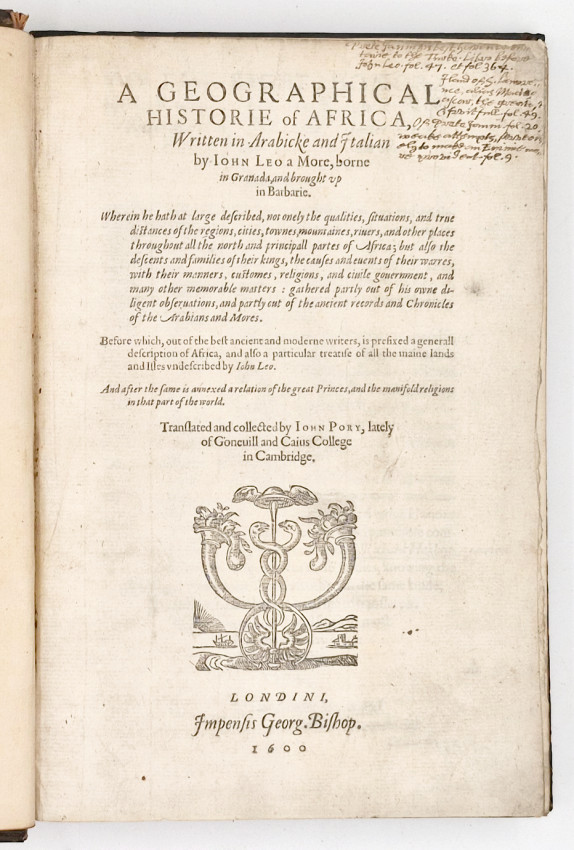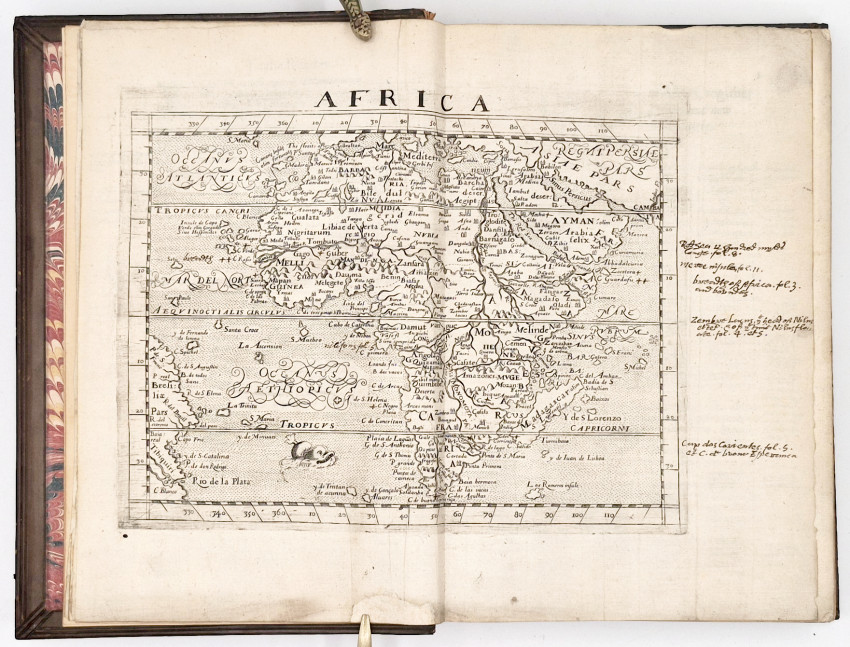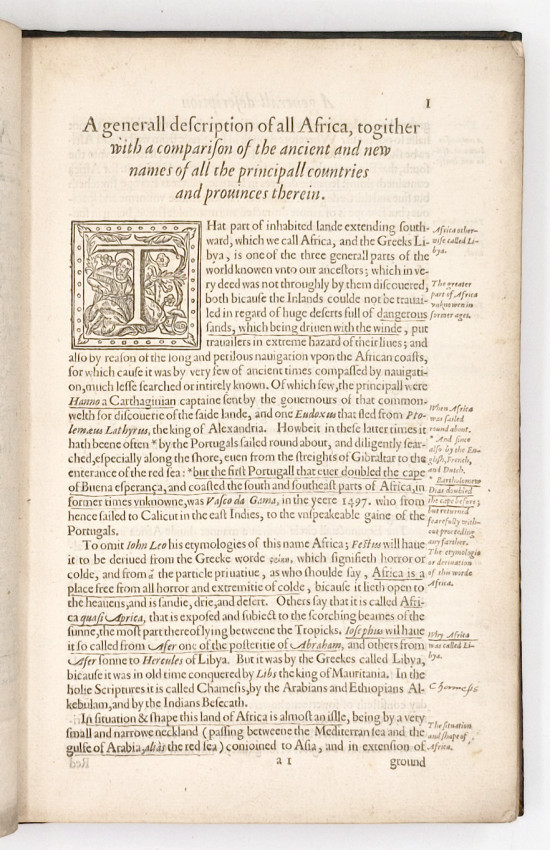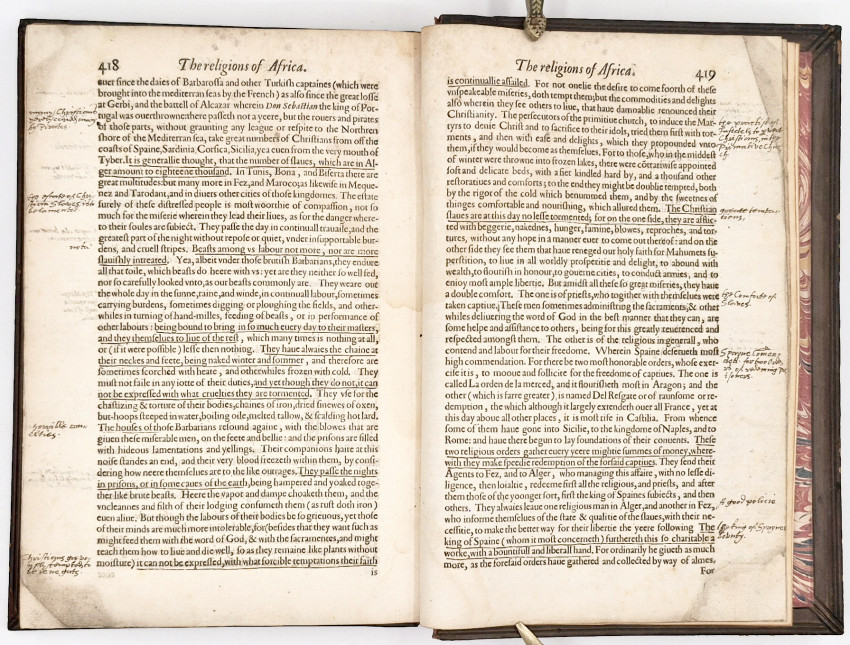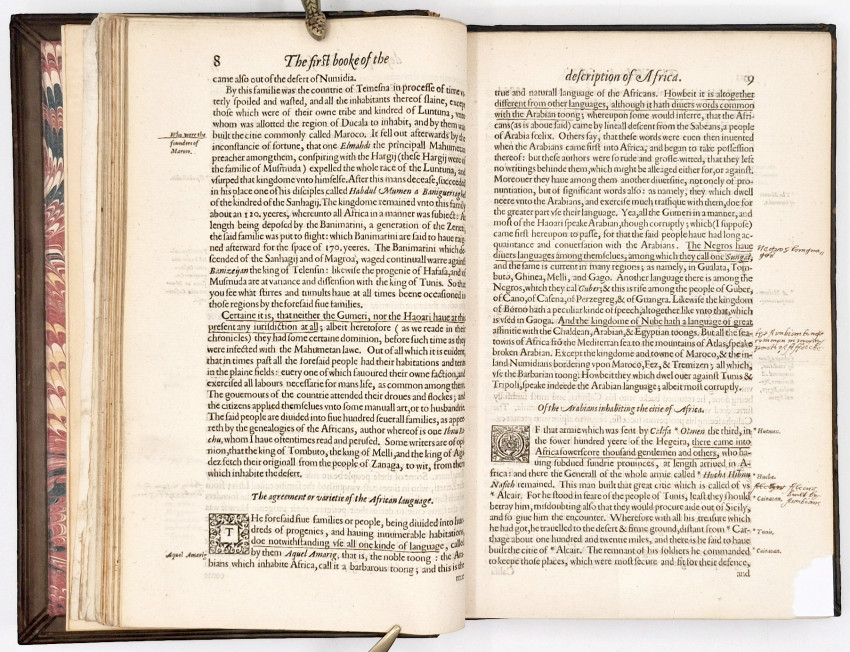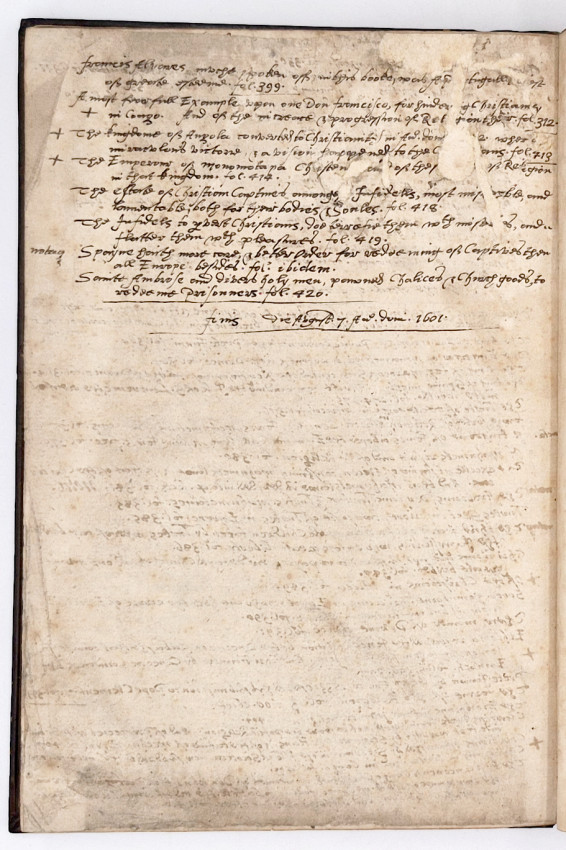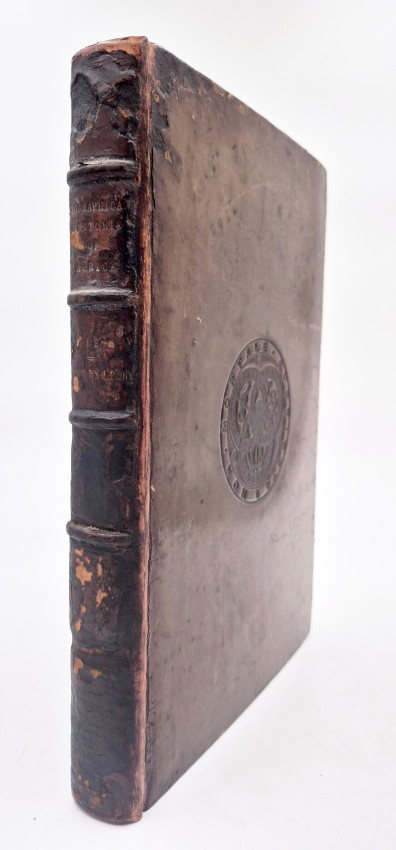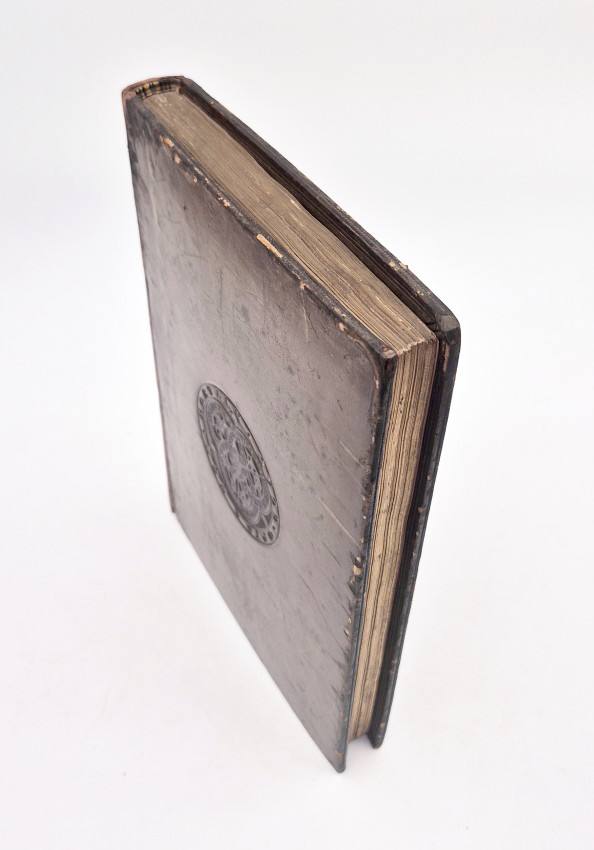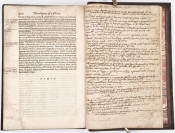Written in Arabicke and Italian by Iohn Leo a More, borne in Granada, and brought up in Barbarie. Wherein he hath at large described, not onely the qualities, situations, and true distances of the regions, cities, townes, mountaines, riuers, and other places throughout all the north and principall partes of Africa; but also the descents and families of their kings, the causes and events of their warres, with their manners, customes, religions, and civile government, and many other memorable matters gathered partly out of his owne diligent obseruations, and partly out of the ancient records and Chronicles of the Arabians and Mores. Before which, out of the best ancient and moderne writers, is prefixed a generall description of Africa, and also a particular treatise of all the maine lands and isles vndescribed by Iohn Leo.
Translated and collected by Iohn Pory, lately of Goneuill and Caius College in Cambridge
First Edition in English: (xviii), 60, 420 pages, fine double page map of Africa mounted on a stub, many large woodcut ornamental initials, paper flaw in the lower corner of leaf 9/10, and the lower corner of the last leaf of text neatly repaired, otherwise the contents are clean and fresh. Marginalia and underlining throughout all by the original owner who carefully annotated the text and added a four page table of contents at the end locating the subjects of particular interest to him, with a date and purchase note. Also a note in the same hand at the top of the title page. Bound in 19th century olive calf preserving the original backstrip, both covers with a blind-stamped central medallion bearing the armorial device of Sir William Stirling-Maxwell (1818-1878), marbled endpapers, all edges gilt. Circular book plate of Stirling-Maxwell on the front paste-down endpaper, a very good copy.
Scottish historian, art collector, bibliophile, and politician, owned one of the finest copies of Pory’s translation of A Geographical Historie of Africa. His library catalogues and sale records (Keir sale, 1881) list the book. Collectors and bibliographers in the 19th century often cited “Stirling-Maxwell copy” as a reference point for condition or completeness of early travel books.
Wikipedia (https://en.wikipedia.org/wiki/Leo_Africanus) 'Johannes Leo Africanus (born al-Ḥasan ibn Muḥammad ibn Aḥmad al-Wazzān al-Zayyātī al-Fasī, ; c. 1494 – c. 1554) was an Andalusi diplomat and author who is best known for his 1526 book Cosmographia et geographia de Affrica, later published by Giovanni Battista Ramusio as Descrittione dell'Africa (Description of Africa) in 1550, centred on the geography of the Maghreb and Nile Valley. The book was regarded among his scholarly peers in Europe as the most authoritative treatise on the subject until the modern exploration of Africa. For this work, Leo became a household name among European geographers. He converted from Islam to Christianity and changed his name to Johannes Leo de Medicis (Arabic: يوحنا الأسد, romanized: Yuḥannā al-Asad). Leo possibly returned to North Africa in 1528.
'Biography: Most of what is known about his life is gathered from autobiographical notes in his own work. Leo Africanus was born as al-Hasan, son of Muhammad in Granada around the year 1494. The year of birth can be estimated from his self-reported age at the time of various historical events.[4] His family moved to Fez soon after his birth. In Fez he studied at the University of al-Qarawiyyin (also spelled al-Karaouine). As a young man he accompanied an uncle on a diplomatic mission, reaching as far as the city of Timbuktu (c. 1510), then part of the Songhai Empire. In 1517 when returning from a diplomatic mission to Constantinople on behalf of the Sultan of Fez Muhammad II he found himself in the port of Rosetta during the Ottoman conquest of Egypt. He continued with his journey through Cairo and Aswan and across the Red Sea to Arabia, where he probably performed a pilgrimage to Mecca.
'On his way back to Tunis in 1518 he was captured by Spanish corsairs either near the island of Djerba or more probably near Crete, and imprisoned on the island of Rhodes, the headquarters of the Knights Hospitaller. The usual fate of unransomed Muslim captives was slavery in Christian galleys, but when his captors realized his intelligence and importance, he was moved to the Castel Sant'Angelo in Rome and presented to Pope Leo X. He was soon freed and given a pension to persuade him to stay. He was baptized in the Basilica of Saint Peter's in 1520. He took the Latin name Johannes Leo de Medicis (Giovanni Leone in Italian). In Arabic, he preferred to translate this name as Yuhanna al-Asad al-Gharnati (literally means John the Lion of Granada). It is likely that Leo Africanus was welcomed to the papal court as the Pope feared that Turkish forces might invade Sicily and southern Italy, and a willing collaborator could provide useful information on North Africa.
'Leo Africanus left Rome and spent the next three or four years traveling in Italy. The death of his patron Leo X in 1521, and suspicions from the new Pope Adrian VI against a Muslim in court, was likely the reason for his leaving Rome. While staying in Bologna he wrote an Arabic-Hebrew-Latin medical vocabulary, of which only the Arabic part has survived, and a grammar of Arabic of which only an eight-page fragment has survived. He returned to Rome in 1526 under the protection of the new Pope Clement VII, a cousin of Leo X who replaced Adrian. According to Leo, he completed his manuscript on African geography in the same year. The work was published in Italian with the title Della descrittione dell'Africa et delle cose notabili che ivi sono, per Giovan Lioni Africano in 1550 by the Venetian publisher Giovanni Battista Ramusio. The book proved to be extremely popular and was reprinted five times. It was also translated into other languages. French and Latin editions were published in 1556 while an English version was published in 1600 with the title A Geographical Historie of Africa.[6] The Latin edition, which contained many errors and mistranslations, was used as the source for the English translation.
'Pope Leo X was Leo's initial benefactor in Rome. His cousin, Giulio de' Medici later became Pope Clement VII and continued the papal patronage of Leo.
'There are several theories of his later life, but none of them are certain. According to one theory, he spent it in Rome until he died around 1550, the year Description of Africa was published. This theory was based on indirect allusion in a later preface to this book. According to another theory, he left shortly before the Sack of Rome by Charles V's troops in 1527. He then returned to North Africa and lived in Tunis until his death, sometime after 1550. This was based on records by German orientalist Johann Albrecht Widmannstetter, who arrived in Italy and planned (but ultimately failed) to travel to Tunis to meet Leo who had since reconverted to Islam. Yet another theory said that he left Tunis after it was captured by Charles V in 1535 for Morocco, his second home country after Granada where his relatives were still living. This was based on the assumption that Leo, having left Granada, would not have wanted to live under Christian Spanish rule again, and his wish (recorded in Description of Africa) that he wanted to ultimately return to his home country "by God's assistance".
'Veracity of Africa trip: It is possible that Leo Africanus did not visit all the places that he describes and relied instead on information obtained from other travellers. It is doubtful whether he visited Hausaland and Bornu and it is even possible that he never crossed the Sahara but relied on information from other travellers that he met in Morocco. The historian Pekka Masonen has argued that the belief of his further travels was based on misreadings by modern scholars who interpreted his book as an itinerary. At the time Leo visited the city of Timbuktu, it was a thriving Islamic city famous for its learning. Home to many scholars and learned men, Timbuktu also possessed a Great Mosque, renowned for its expansive library. The town was to become a byword in Europe as the most inaccessible of cities. At the time of Leo's journey there, it was the centre of a busy trade carried on by traders in African products, gold, printed cottons, slaves and in Islamic books.'
Shakespeare's Othello and Leo Africanus: Since this first English translation of A Geographical Historie Of Africa was published in London in 1600 Shakespeare likely encountered Leo's description of Africa through the translation by John Pory, which provided a European audience with a first hand, though sometimes problematic, accounts of African geography, culture, and people. Scholars believe aspects of Leo's descriptions of African character traits, presented in his work, were adapted by Shakespeare to shape Othello's characterisation when he wrote the play in 1603.
Londini, Impensis Georg. Bishop, 1600
See also:
Masonen (Pekka): Leo Africanus: The Man with Many Names (https://leoafricanus.com/pictures/bibliography/Masonen/Masonen.pdf)
Howgego (Raymond John) Encyclopedia of Exploration, Volume I, A17, page 9.
- Overall Condition: Very good
- Size: Small folio (265 x 180 mm)
- Sold By: Clarke's Africana & Rare Books
- Contact Person: Paul Mills
- Country: South Africa
- Email: [email protected]
- Telephone: 021 794 0600
- Preferred Payment Methods: Visa & Mastercard via PayGate secure links and Bank transfers.
- Trade Associations: ABA - ILAB, SABDA


